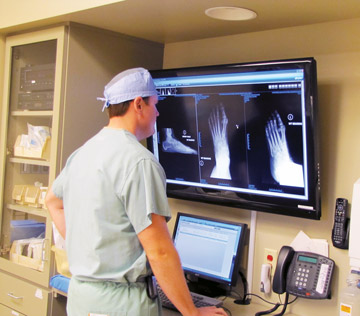"Fractures of the finger, wrist, ankle, forearm, elbow or humerus that don't affect nerves or the vascular system can be treated acutely with a splint, and scheduled electively in an outpatient facility," says Dr. Romeo.
If your facility already performs elective orthopedic and sports injury cases, there isn't a lot of equipment you need to buy for trauma care, says Dr. Romeo.
- C-arm. This is typically the biggest capital equipment item you may need to purchase. A full-size C-arm, along with the required safety equipment, health department approvals and maintenance fees, can cost around $100,000. Additionally, Dr. Romeo notes that more surgeons are using 3D CT navigation systems to plan procedures, with the images broadcast on flat screen monitors in the OR. Manufacturers of 3D C-arms claim their technology provides enhanced images of anatomy to help surgeons better determine where to place pins and plates. The technology can tack on an extra $50,000 to $100,000 to the cost of a regular C-arm.
- Ultrasound. If your anesthesia providers aren't already performing ultrasound-guided nerve blocks, you'll likely need to purchase an ultrasound unit. Though ultrasound machines can cost up to $100,000, manufacturers of new compact units say their systems offer the same image quality with a smaller footprint and price tag. Also make sure you have a quality anesthesia team in place that can place the blocks appropriately and quickly, says Dr. Bettin.
- Instruments. On the supply side, surgeons will want access to a set of mini, small and large fragment instrument and implant sets, which are necessary to pin or plate a variety of fractures.
- Implants. If your surgeons need a specialty implant, you can often work out agreements with vendors to get what they need on short notice.
"Surgeons working on a complex fracture of the lateral clavicle would probably need to call a vendor 24 hours beforehand, so they can deliver devices needed for the case," says Dr. Romeo. "Fortunately, trauma care has been spectacularly supported by the orthopedic medical implant industry, so you can call company representatives who provide trauma sets, and they will often be at your facility within hours."
The difference between performing profitable procedures and operating in the red often comes down to the cost of the implants. Although Dr. Bettin's study found that implant costs for outpatient fracture cases tend to be lower than those for inpatient procedures, he says surgeons who are unaware of the costs can easily double or triple the expense of an individual case.
"There are a lot of ways to fix fractures with implants, and you can often achieve the same quality of repair with different implants that can range in price," he says.
For example, Dr. Bettin notes that surgeons can use non-locking plate implants starting at around $500 for repairing a fibula ankle fracture. "But locking-plate implants in which screws engage with the plate — which tend to be used in more complicated cases — can run between $2,000 and $4,000."
Medicare and Medicaid typically do not reimburse for implants, according to Dr. Bettin, who says private insurers are more likely to cover the cost of an implant by working it into the overall reimbursement for the case, though the amount varies depending on the contract.
Patients are in the OR by 7 a.m. and on their way home by 11 a.m.
— Anthony A. Romeo, MD
"Some insurers will pay only the cost of the implant, some will include an extra 1% to 3% for processing charges and some will reimburse a higher overall rate for the procedure to help offset the implant costs," explains Dr. Bettin. "You need to have good communication with your payers, a solid precertification process and make sure the cost of the implant is covered before performing procedures."
Surgeons need to be aware of the cost of implants and the reimbursement contracts with third-party payers, adds Dr. Romeo. He says, "When the cost of one implant is remarkably different than another, and they both provide the same outcomes, the cost of the more expensive device has to be negotiated lower, or the surgeon should switch to the less expensive but equally effective device."
.svg?sfvrsn=be606e78_3)

.svg?sfvrsn=56b2f850_5)